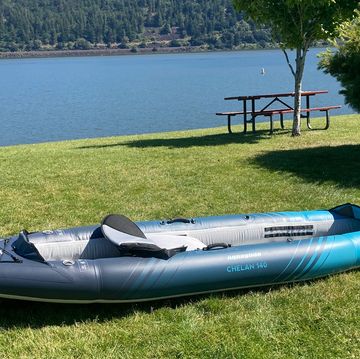"People ask me all the time: 'How hard is it to throw a boomerang?'" says Eric Darnell, a 62-year-old boomerang inventor from South Stafford, Vt. "Throwing a boomerang is easy. It's making it come back that's hard."
Darnell, the subject of a feature in the new issue of PM, is only partially kidding: Throwing a boomerang takes practice, like any other sport—and a number of variables ensure that a little magic is involved, too. Here, Darnell outlines the 'rang rules that separate a successful throw from one that eats dirt. —Erin McCarthy
1. Mind the wind (and where you're throwing).
The direction and velocity of the wind, as well as whether it's steady or swirling, play a big role in the success of a throw. "A lot of times, a person's first experience trying to throw a boomerang is in a backyard where there are trees and the wind is tumbling," Darnell says. "In a situation like that, you're probably never going to get a good return." He recommends finding a field to throw in, where the air will be somewhat undisturbed. Tossing some grass up in the air will give you an indication of where the wing is headed. If you're a right-handed thrower, you'll be throwing to the right of the wind, so face the wind and pick up some more grass in your left hand. Sprinkle it out slowly, turning to the right until the grass is blowing past in front of you from left to right. The breeze will be hitting your left cheek instead of straight-on. (Left-handed throwers should do the mirror image of this.)
2. Get a grip.
Your handle on a boomerang often depends on preference and ability, but for beginners, Darnell recommends holding either the lead wing (for 'rangs with more than 90 degrees between the wings) or the trailing wing (if there's less than 90 degrees between the wings). The curved side should face you—otherwise, the boomerang won't generate lift. You can use a pinch grip by holding the wing of the 'rang between your thumb and forefinger or a cradle grip, which is similar to the pinch grip—just wrap your forefinger around the front edge of the wing.
3. Find your angle.
You need to throw your boomerang in relation to the wind—not an easy task. "It varies so much, it's amazing," Darnell says. "But anywhere between 45 and 90 degrees off the wind might be appropriate for the boomerang in your hand." The narrower the angle between the wings, the more off the wind you're going to throw. "If you have a boomerang shape of less than 90 degrees, you'll throw closer to 90 degrees off the wind. If you have a 'rang that's 120 degrees, you'll be throwing 45 degrees off the wind." If you're right-handed, throw to the right of the wind, and vice versa for left-handed throwers.
4. Forget your Frisbee skills.
The angle at which you tilt your boomerang before throwing is called layout, and it's essential to a successful throw. Darnell recommends beginning with the boomerang almost perpendicular to the ground—about 10 to 15 degrees away from vertical (the boomerang should be tilted away from your head, not in toward it). "The harder you throw, the more vertical it should be; if you throw softer, the 'rang can be more laid out." Don't throw your boomerang horizontally, like a Frisbee—it will go straight up and land who knows where, but certainly not where you wanted it.
5. Aim higher.
When throwing your boomerang, it's important to determine how far above the horizon you want to throw. Darnell recommends finding an object in the distance and aiming for it. "If you're in a field and there are some trees in the distance, aim for the tops of those trees," he says. "You want to throw above your own height."
6. Use some fancy footwork.
Before you can throw your 'rang, you have to master a move known as casting the foot out. When you're getting ready to throw, turn your right foot out and pick your left foot up, balancing on your right foot. Step forward with your left foot at the same time you throw (again, lefties will do the opposite). "This gets your body's weight and energy into the throw, and not just the arm," Darnell says.
7. Throw—and spin.
Instinct may tell you to throw your boomerang across your body like a Frisbee—but instinct would be wrong. "It's more like throwing a dart," Darnell says. And the force of your throw is sometimes less important than the spin, which gives the 'rang gyroscopic stability. Snap your wrist in the direction of the target—don't twist it—at the end of your throw to impart spin.
8. Catch.
Your boomerang is coming at you—fast. Now what? "Some people turn around and run," Darnell says. "It's like running down the railroad tracks when the train's coming. It's not a good plan." Instead, keep your eyes on the 'rang; step aside and let it go by, like a matador would a charging bull. As a general rule, you shouldn't throw your boomerang if there are other people around, but if there are, make sure to yell "head's up" to let them know a 'rang is headed their way. If your boomerang is hovering down to you, the safe way to catch it is at chest level or below between the palms of your hands (known as the sandwich catch).
When it comes to throwing a 'rang, practice makes perfect— sort of. The subtleties and variables involved in this sport can humble even the most accomplished aficionados. "What you're trying to do is basically impossible," Darnell says. "The concept of taking something and throwing it away from yourself as hard as you can, and it comes back all by itself, right there you're looking at magic. It doesn't make sense." And the learning curve never ends. "I've been doing this 50 years, and I learn something every time I throw," he says. "That's the fun part."













